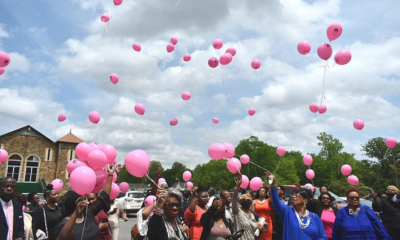Featured
October – Breast Cancer Awareness Month

October typically reintroduces magnificent, beautiful fall colors and brings a welcomed reprieve from the summer heat. The month culminates with jack-o-lanterns, haunted houses, ghosts and ghouls, and the ever so kid friendly trick-or-treating. Nature prepares for winter so she can reappear reinvigorated in spring.
In an effort to bring awareness to prevention and treatments of breast cancer, October is also breast cancer awareness month. National Breast Cancer Awareness Month (NBCAM) is a collaboration of medical associations, public service organizations, and governmental agencies with the goal of empowering women through education and support for breast health.
The awareness of breast cancer is vital for Black women because their death rates are disproportionately higher from the disease and it’s the most common type of cancer in this group.
Breast cancer starts in the tissues of the breasts. There are two main types:
• Ductal carcinoma, the most common type, originates in the tubes that carry milk from the breast to the nipple.
• Lobular carcinoma originates in the part of the breast that produces milk, called lobules.
Cancer can start in other areas of the breast, but these are rare instances.
Breast cancer can be invasive or noninvasive. Cancer that has spread from the part of breast where it started to other tissues means it is invasive. Breast cancer that has not spread to other tissues, isolated or localized to a particular part of the breast, is noninvasive. Noninvasive cancer has an increased risk of becoming invasive if left untreated.
Risk factors specific to the onset of breast cancer include:
• Age and gender — Development of breast cancer increases with age. Advanced cases of breast cancer are usually found in women over fifty years old and women are 100 times more likely than men in developing the disease.
• Family history — Approximately 20 – 30% of women who develop breast cancer have a family history of the disease. There’s also an increased risk for breast cancer with a family history of uterine, ovarian, or colon cancer.
• Genes — There are genes that produce proteins that protect against cancer. If a parent passes on a defective gene (BRCA1 and BRCA2 genes) there is a greater risk for breast cancer. There is an 80% chance of developing breast cancer in women with this genetic defect.
• Menstrual cycle — There is an increased risk for breast cancer in women who go through menopause after fifty-five years of age and in young girls who start their menstrual cycle before age twelve.
• Alcohol consumption — Daily consumption of more than 1 to 2 glasses of alcohol increases breast cancer risk.
• Childbirth — Childless women and women who delay childbirth past age thirty increases the risk. Pregnancy at an early age and multiple pregnancies decreases your breast cancer risk.
• Diethylstilbestrol — This is a drug administered to women in the 1940s thru 1960s to prevent miscarriages. Women who took this medication had an increased risk for breast occurs after age forty.
• Hormone replacement therapy — Prolonged, several years, of exposure to hormone replacement therapy with estrogen increases the risk.
• Radiation — Radiation treatment for cancer in the chest area as a young adult or child increases your risk for breast cancer. Such treatment given during breast development and in higher doses means higher risk.
Many breast cancers are sensitive to the hormone estrogen, meaning estrogen has the effect of causing tumors to grow. These cancers have estrogen receptors on the surface of their cells. They are called estrogen receptor-positive cancer.
Some women have a gene called HER2. These genes help cells grow, divide, and repair themselves. When cancer cells have too many copies of the HER2 gene, they grow faster. HER2-positive breast cancer is more aggressive and has a higher risk of recurrence. Treatments specifically designed to combat the effect of the HER2 gene may improve outcomes.
There are usually no symptoms of breast cancer in its early stage. As the cancer advances symptoms include:
• breast lumps or hard lumps in the armpits with irregular edges that present with no pain
• change in the size, shape, or feel of the breast or nipple • clear or discolored fluid emanating from the nipple,may have the appearance of pus
Symptoms of breast cancer in advanced stages include:
• bone pain
• pain and discomfort in the breast
• skin ulcers
• swelling in the arm nearest to cancerous breast
• weight loss
There’s a theory that obesity is directly linked to breast cancer because obese women produce more estrogen thereby making them more susceptible to estrogen-receptor positive cancer. The theory is controversial, so questions persist about this link.
Evidence that pesticides are linked to breast cancer does not exist. However, un1derwire bras, antiperspirant use, and breast implants do not increase breast cancer risk.
Many of the risk factors associated with breast cancer are beyond the control of most women, such as genes and family history. Therefore prevention options are few. The best available advice for prevention is to eat a well balanced diet that includes whole grains instead of refined grains, eating five or more servings of fruit and vegetables per day, limit processed and red meat, utilize portion control to maintain a healthy weight, and limit alcohol to one drink per day. Completely avoid alcohol consumption if you’re in a higher risk category.2
Women who have had one breast removed due to cancer, women with a family history of breast cancer, and women with defective genes or genetic mutations are considered high risk and may consider a prophylactic mastectomy, the surgical removal of the breast before cancer is diagnosed. This procedure reduces your risks for cancer, but does not completely eliminate the risk.3
In rare cases, men can develop breast cancer. Although the risk is low, 1% of the breast cancer cases, the disease is not isolated to women. Some degree of vigilance is required by men too. Men who wish to become informed on how to become capable caregivers if the disease strikes the women in their lives should visit the Men Against Breast Cancer’s website. (www.menagainstbreastcancer.org)4
Breast MRIs, ultrasounds, biopsies, and CT scans are used for detecting and monitoring breast cancer. Another important tool in detection is breast self-exams. According to John Hopkins Hospital, “forty percent of diagnosed breast cancers are detected by women who feel lumps.” However, breast self-exams should not be used as the only tool for cancer detection.
It’s recommended that breast self-exams be done monthly by women of all ages because the exams are useful in familiarizing women with their breasts so subtle changes may be more easily recognizable. Screenings are important because tumors can be detected before they are felt. Early detection is key to the overall prognosis. (Detailed instructions and illustrations on how to perform the breast self-exam can be
_________________________________________
1 U.S. National Library of Medicine, “Breast Cancer”, www.ncbi.nlm.gov/pubmedhealth/ PMH0001911/
2 American Institute for Cancer, “Foods That Fight Cancer”, www.aicr.org/ food.that.fight.cancer
3 U.S. National Library of Medicine, “Breast Cancer”, www.ncbi.nlm.gov/pubmedhealth/ PMH0001911/
4 Men Against Breast Cancer, “Caring About the Women We Love”, www.menagainstbreastcancer.org
found on the National Breast Cancer’s website: www.nationalbreastcancer.org/breast-self-exam)5
Breast cancer stages range from 0 to IV (0 – 4). Stage 0 is noninvasive and has effective treatments. Stages IV is invasive and the goal of treatment is to extend life and ameliorate symptoms. Stage IV breast cancer usually cannot be cured.
According to some estimates, as many as 1,700 Black women die needlessly annually from breast cancer. Although white women are stricken with this disease more often, Black women have the higher mortality rate and more often develop the disease before forty-five years of age. This finding prompted a study by the Sinai Urban Health Institute in Chicago to discover the possible cause or causes of the higher mortality rate.
Genetics were suspected of playing a substantial role in the mortality rate. Yet, the study concluded that poverty, silence, and racial inequities were major contributors to the increased mortality, not genetics. Black women lack access to information and proper care. Cultural norms of fear and hopelessness lead Black women to delay seeking prompt medical attention.
The prognosis is always better with breast cancer with early detection. Health concerns should be addressed immediately with your health care provider. Your health care provider will customize a treatment or combination of treatments, according to the cancer stage, which hopefully will return you to ideal health.6
A diagnosis of breast cancer does not have to be fatal. There is no shortage of useful information on the subject. Informed decisions are usually the best decisions. Look for support groups and never, never be silent! Experience should never be a silent teacher, sharing the details of a traumatic experience could lessen the burden for someone enduring a similar fate.
Remember, the word “cancer” evokes fear. Knowledge conquers fear!!!
_________________________________________
5 National Breast Cancer, “Breast Self-Exam”, www.nationalbreastcancer.org/breast- self-exam
6 “Breast Cancer Mortality Rates for African American Women Disproportionately High”, Shanti Norris and Carole O’Toole, Washington Post 04/09/2012, www.washingtonpost.com

-

 Featured10 months ago
Featured10 months agoCalifornia Is the First State to Create A Public Alert for Missing Black Youth
-

 Featured10 months ago
Featured10 months agoAfrican American Leaders Stay the Course Amid Calls for President Biden To Bow Out of Race
-

 Featured10 months ago
Featured10 months agoThe Debate Fallout Lands on Both Candidates
-

 Featured9 months ago
Featured9 months agoPresident Joe Biden Decides to Withdraw from the Presidential Race
-

 Featured10 months ago
Featured10 months agoPresident Joe Biden Describes Shooting of Donald Trump As ‘Sick’
-

 Featured9 months ago
Featured9 months agoIn One of His Final Speeches as President, Biden Says It’s Time for ‘Fresh Voices’

